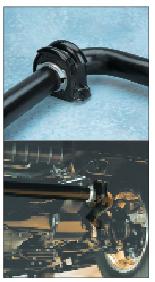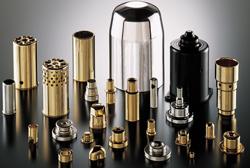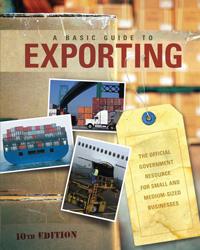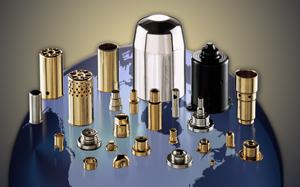- FMA
- The Fabricator
- FABTECH
- Canadian Metalworking
Categories
- Additive Manufacturing
- Aluminum Welding
- Arc Welding
- Assembly and Joining
- Automation and Robotics
- Bending and Forming
- Consumables
- Cutting and Weld Prep
- Electric Vehicles
- En Español
- Finishing
- Hydroforming
- Laser Cutting
- Laser Welding
- Machining
- Manufacturing Software
- Materials Handling
- Metals/Materials
- Oxyfuel Cutting
- Plasma Cutting
- Power Tools
- Punching and Other Holemaking
- Roll Forming
- Safety
- Sawing
- Shearing
- Shop Management
- Testing and Measuring
- Tube and Pipe Fabrication
- Tube and Pipe Production
- Waterjet Cutting
Industry Directory
Webcasts
Podcasts
FAB 40
Advertise
Subscribe
Account Login
Search
Want to export? Cozy up to your globalizing customers
Stampers find road to international markets via clients, other resources
- November 30, 2009
- Article
- Shop Management
While some stampers have experienced demand losses when their clients set up manufacturing facilities offshore, others have successfully co-piloted their customers' global expansions to supply to them in their new digs.
In each case, two common themes emerge apparent: The stamping manufacturers produce unique, and sometimes difficult-to-manufacture, components and assemblies, and they have strong relationships with domestic customers that migrated offshore.
In one case, an exporting stamping company said manufacturing a very difficult part prompted a customer to reverse an earlier decision to outsource the work because a Chinese supplier could not produce it.
Waukesha Metal Products
For contract manufacturer and stamper Waukesha Metal Products, Sussex, Wis., exports constitute about 40 percent of its shipments. "We sell 30 percent of our product mix to Mexico, another 10 percent around the globe," Jeffrey Clark, president and CEO, explained. "Our largest share of customers have migrated a lot of their assembly operations—to Mexico predominantly. We found that our relationships really drive where we ship product. I would say, for companies of our size, it [exporting] really has to be customer relationship-driven.
"I think it's very onerous and difficult for North American manufacturers to really travel outside of this region to establish a sales effort into those markets without a [customer] location. If it's a general contract business, it's going to be very tough to move that outside.
"If you have something that your customer wants and that customer goes other places, that's really the method," Clark said.
Patented Product."Our business has really grown from two methods—one, our customer relationships are very sound, and our processes and cost-competitiveness make it worth it to them to move us around the globe with them. And second, with a patented product, there's just really no option for them to acquire it elsewhere. So once you make it onto a platform or make it onto a product line, you're pretty locked in.
"We have a patented product that's been put onto the Toyota world truck platform, so we've traveled with that [see Figure 1]. So wherever there is production for that platform, we ship our product."
Border Facility."Within the next six to 12 months we will establish a border facility to supply all of our Mexico shipments to support those customers—we have six to eight established customers in Mexico—and actually expand our reach into Mexico," Clark said.
The company ships a smaller share of its products to China, Taiwan, and India. "Because of our relationship with a customer, we do end up traveling to where their production requirements are."

Figure 1Waukesha Metal Products manufactures a patented product that's been put onto the Toyota world truck platform, which has been key to its export strategy. Photo courtesy of Waukesha Metal Products, Sussex, Wis.
Resource—Siting. Clark said the company has used government and municipal agencies, both in Mexico and in the U.S., to explore locations and incentives for siting its plants there. Some Economic Development Councils (EDC) offer incentive programs to help locate and develop plants or properties or offer training grants, he said.
"Government agencies can help facilitate the necessary permitting processes. We needed more help in Mexico just because it is a foreign country.
"On the U.S. side, we just started by contacting the local Economic Development Councils. In Mexico, some of our customers have pointed us to the appropriate government officials to start those conversations."
In terms of permitting, Clark said customers manage most of the export paperwork, although he has used bank and customer sources to verify appropriate shipment terms, which can vary from country to country.
Resource—Sales Representation."We also have sales representation in Mexico as well as along the U.S. border. So we do sell to the maquiladoras and the businesses that we may not have been doing business with. We leverage our experience of shipping into Mexico."
Trans-Matic Mfg.
Trans-Matic Mfg. Co., Holland, Mich., traveled the route to the world seamlessly via its customers also. "Our export business typically is customer-driven," said Mark Southwell, vice president of sales and marketing.
"We actually export to over 20 different countries in North America, Europe, a little to South Africa, Brazil, and then seven different countries in Asia. Some are one shipment a year and some are pretty heavy."
Canada and Mexico are the main destinations for the company's exports, Southwell said. Most of the customers' headquarters are in the U.S. or Germany. "In our case, we supply Tier 1s in the U.S. that have plants outside the U.S—mostly in Mexico." Southwell said that exports to Canada have declined and Mexico increased.
Product Niche. The company forms deep-drawn, thimble-sized, under-the-hood engine and transmission components (see Figure 2).
"I think for us, the big difference that we have is we're such a niche; we have few competitors in Mexico. Deep drawing is not as common as other types of stamping, and most of our parts are very small."

Figure 2Trans-Matic Mfg. Co. deep-draws thimble-sized, under-the-hood engine and transmission components that are exported to more than 20 countries. Photo courtesy of Trans-Matic Mfg. Co., Holland, Mich.
Facility Proximity."We put a plant in the Southwest, too, in Mesa, Arizona, to take advantage of the opportunities to sell into Mexico in '92, after NAFTA passed. That appeals to our customers in Mexico because of the proximity. So we're able to manufacture in the States but still be close to Mexico, so that there is a logistical advantage to that."
Trans-Matic stores product in consigned warehouses that its customers set up on both sides of the border. "With consigned warehouses, you still own the product. You actually pay for the space and insure the product, and the customer pulls the product as needed. When they pull the product, they pay you. They are sited near the border where there's good transportation or in proximity to the customer. It just depends on how the customer wants to do it."
Southwell emphasized that warehousing is an arrangement he would agree to only for top customers. "You wouldn't do this for a one-hit wonder or a small customer; you'd do this with a significant customer. It's really just a willingness to work with our customer."
Southwell said that the transportation costs are not so much a factor in the proximity advantage as much as is the immediacy. "It's more of a comfort in the response time—we're closer so we can respond faster."Trans-Matic set up a plant in a suburb of Shanghai to service Asia—mostly China. "So we're trying to set up in the regions we need to service customers in China. And most of those customers are similar—they're mostly German and American companies—a few Chinese companies. The technology in China is still in its infancy there, so we're able to hit the ground [running] with 41 years of experience."
FOB—End of the Worry. Southwell said his customers handle most of the product shipments. "With NAFTA, it does almost seem like there's not a border there. Most of our products in North America are FOB [free on board]. So once they leave our dock, we have very little to do with export paperwork, transportation, all of that. We have NAFTA paperwork to fill out, but for the most part, our customers handle all of the customs and transportation duties." He said this arrangement works well. "Customers tend to consolidate shipping. They're more accustomed to moving a volume of products."
Manufacturing Similarities. Southwell said that there is little, if any, difference in the way products are manufactured for stateside or foreign plants. "Their expectations, their management, their systems are all similar between the U.S. and Mexico. Actually, they're really similar worldwide, in terms of APQP and AIAG requirements, PPAP requirements, or in our case, automotive ISO/TS 16949.
"There still is so much U.S. influence on Mexico that our company's reputation within the U.S. is carried over, just by the transfer of work from the U.S. to Mexico."
Southwell said he would welcome the opportunity to ship to other foreign facilities.
"So now would a Mexican buyer from a company down there shift companies and go to another company and say, 'Hey, I worked with this good supplier of deep-drawn parts. I recommend these guys'? Yeah, I'm sure that happens. But most of the manufacturers in Mexico have U.S. or German bases."
Resources—Trade Councils, Associations. Southwell said the company sought help from the Van Andel Global Trade Center, which is part of Grand Valley State University in Grand Rapids, Mich. "I think those types of collaborations between trade centers and universities are common. They offer a lot of seminars and get-togethers to help companies trade globally.

Figure 3The U.S. Export Assistance Center, part of the U.S. Commercial Service, offers guidance and assistance to small and medium-sized manufacturers wanting to export. Image courtesy of U.S. Commercial Service.
"The Department of Commerce is very good at rallying people, making sure people get exposed to it, but they learn a lot too. They don't invent this stuff."
Southwell suggested membership in trade associations such as the Fabricators & Manufacturers Association (FMA) and the Precision Metalforming Association (PMA) for the networking possibilities they offer. "You're able to meet with other members and say, 'How do you guys handle this?' You can get some information from other companies in the same boat."
Resource—Customers."I'd like to say that we're brilliant about it [exporting], but mostly, customer relationships are such a big part of it. If your customer wants something or needs something from you, they're going to do everything in their power to help you to export it," Southwell said.
"Your customers can be extremely helpful in bringing product to their end. They need you. With a significant customer, if we need to know how to move data quicker, or how to deal with the local government agency, it's not uncommon for our company president to call the VP or president of the foreign facility and say, 'Hey, can you help us out with this?'
"Because they've already had enough bumps along the road to say what works and what doesn't work. They've got examples of suppliers that are doing it the way they want it to be done, so they'll say, 'This is how another supplier handles this.'
"When you have built up those relationships and you make something they need, they want you to succeed. In our case, we've got somewhat of an engineered component. It's not a washer. They know we can hit the ground faster," Southwell said.
Go and Talk. Exporting means traveling and asking questions, Southwell said. "You've just got to go and see the site. Whatever market you're going to export to, expect to have to do an intense amount of travel for several years.
"You've got to go and talk to your customers, sit down with them at their locations overseas to work out the logistics, and just ask, 'How does this work? How do you want us to work with you? What are your expectations?'"
Ramcel Engineering
Ramcel Engineering Co., Northbrook, Ill., a custom tooling, metal stampings, and automated assembly company, also found its export business via its customers.
Resources—Resident Expert."It is often helpful to have an established sales presence—a 'national' in the export country and city location who is familiar with the business culture, customs, and general practices in getting things done �in the destination country," said Dick "Trags" Tragseiler, sales engineer. Doing so�can streamline the introductory process, reduce the learning curve, and shorten new business development, he added.
Border Facilities. Contract manufacturers often are pressured to establish border manufacturing facilities which frequently turn into reworking, sorting, or warehousing facilities, Tragseiler said.
"In a truly global marketplace it becomes increasingly important for customers to fully understand the strengths, capabilities, and expertise of their supply base, including technical support at the very early stages of product development and customer design. Decisions made solely on the basis of the lowest quoted piece part price fail to take into consideration the total costs of delivered product," he added.
Shipping, Specifications
Shipping Arrangements. Export�ing stampers usually ship FOB, and the customer either arranges the freight or directs a freight forwarder to avoid the complexities that are often difficult for a small company to deal with.
Some of the shipping requirements include minimum and maximum box sizes and quantities and special packaging requirements such as those being exported on an ocean-bound carrier.Product Specifications. Most countries use metric measurements so U.S. exporters usually must manufacture or spec the products in metric, rather than imperial measurements. Coordinate measuring machines, calipers, and special gauges can be useful for that effort.
Customers sometimes provide the imperial equivalents of material grades if they are available. In most cases, stampers can buy material to a U.S. standard and then have it certified to the international standard. Japanese auto manufacturers may ask for a JIS spec, and not all of them are converted easily to U.S. specs, so in those cases, stampers have to import the steel from Japan, then stamp the part and ship it back
to Japan.Other Resources
Distributors. Some stampers have found success through export-oriented U.S. distributors like the Republic Group, Arlington, Va. The distributor has a network of suppliers and customers throughout the world. The company won the 2007 Overall Exporter of the Year award from the U.S. Commerce Department. Exports make up 90 percent of its $35 million annual revenue.
Foreign distributors, the flip side to domestic distributors specializing in exports, tend to find suppliers that offer something unique and difficult to source in their local regions.
Government Agencies. The U.S. Commercial Service offers information on marketing, research, trade trips, customer and partner arrangements, as well as assistance with troubleshooting (see How to Get Government Assistance With Exportingsidebar).
Private Agencies. Companies such as TRADEX purport to promote American manufacturers worldwide and publishes a number of online directories.
How to Get Government Assistance With Exporting
Editor's Note: This information was excerpted from www.export.gov.
1. I think that my company's product would be successful in other countries, but I'm not sure how to get started in international business. Is there help for new exporters?
Exporting can be profitable for U.S. companies, large and small. To learn more about getting started, visit the Export Basics section on the U.S. government's export portal, export.gov. You'll be able to take the Export Readiness Assessment and learn how to prepare to enter new markets. You can also talk to trade specialists at the U.S. Commercial Service's Trade Information Center. Call 1-800-USA-TRAD(E).
2. How can I learn about foreign product standards?
Contact the National Institute of Standards and Technology.
3. How can I learn about import or export licensing?
The International Trade Administration's Import Adminis�tration licenses steel imports through the Steel Import Monitoring and Analysis System. Contact the Bureau of Industry and Security and/or U.S. Customs and Border Protection.
4. How do I fill out a NAFTA Certificate of Origin? Are there other documents to be filled out to ship to Canada or Mexico?
Your shipment may need a NAFTA Certificate of Origin and a Shipper's Export Declaration. To learn more about export documentation, visit export.gov.
The U.S. Commercial Service's Trade Information Center or the trade specialists at your local Export Assistance Center can also help you answer these questions. Call 1-800-USA-TRAD(E) or find your local Export Assistance Center.
5. How can I learn more about my product or service's sales potential in overseas markets?
Market research is a good first step to learn about the sales potential of your product or service in countries abroad. The U.S. Commercial Service offers free online market research to U.S. companies seeking to enter international markets. Its database allows you to sort by country, industry, and/or type of market report. Visit the Market Research Library and register to access these reports.
6. How can I locate importers, distributors, sales reps, etc., in an overseas market?
The U.S. Commercial Service has programs and services to help you locate potential business partners overseas. Contact your nearest U.S. Export Assistance Center and speak with an international trade specialist. You can also receive free export counseling and learn more about its programs and services to help you compete around the globe. Call 1-800-USA-TRAD(E) or visit export.gov to find your local Export Assistance Center.
subscribe now

The Fabricator is North America's leading magazine for the metal forming and fabricating industry. The magazine delivers the news, technical articles, and case histories that enable fabricators to do their jobs more efficiently. The Fabricator has served the industry since 1970.
start your free subscription- Stay connected from anywhere

Easily access valuable industry resources now with full access to the digital edition of The Fabricator.

Easily access valuable industry resources now with full access to the digital edition of The Welder.

Easily access valuable industry resources now with full access to the digital edition of The Tube and Pipe Journal.
- Podcasting
- Podcast:
- The Fabricator Podcast
- Published:
- 04/16/2024
- Running Time:
- 63:29
In this episode of The Fabricator Podcast, Caleb Chamberlain, co-founder and CEO of OSH Cut, discusses his company’s...
- Industry Events
16th Annual Safety Conference
- April 30 - May 1, 2024
- Elgin,
Pipe and Tube Conference
- May 21 - 22, 2024
- Omaha, NE
World-Class Roll Forming Workshop
- June 5 - 6, 2024
- Louisville, KY
Advanced Laser Application Workshop
- June 25 - 27, 2024
- Novi, MI
































